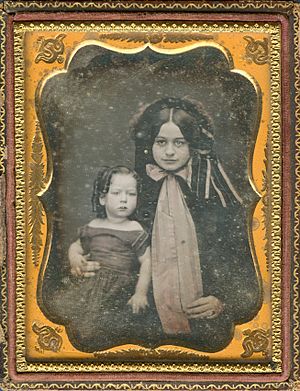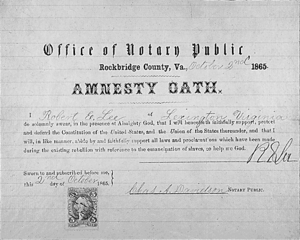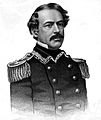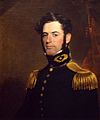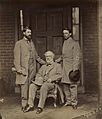Robert E. Lee facts for kids
Quick facts for kids
Robert Edward Lee
|
|
|---|---|
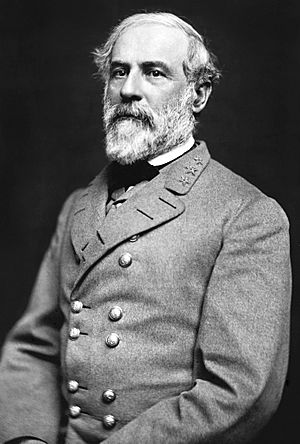
Lee in 1863
|
|
| Born |
Robert Edward Lee
January 19, 1807 |
| Died | October 12, 1870 (aged 63) Lexington, Virginia
|
| Resting place | Lee Chapel Washington and Lee University Lexington, Virginia |
| Occupation | General, Confederate States of America |
| Spouse(s) | Mary Custis |
| Children | 7 |
Robert Edward Lee (January 19, 1807 – October 12, 1870) was an important American soldier. He started his career as a colonel in the United States Army. Later, he became the main general for the Confederate States Army during the American Civil War. He led the Army of Northern Virginia in the eastern part of the war. Lee began as an engineer in the army and moved up through different ranks.
Before the Civil War, Lee was an officer in the Mexican–American War. He also served as the head of West Point, a famous military school. As a colonel, he led a group of marines to stop a rebellion at Harpers Ferry Armory. He captured the leader, John Brown.
Contents
Early Life and Education
Robert E. Lee was born on January 19, 1807, at Stratford Hall Plantation in Westmoreland County, Virginia. His father was Henry "Light-Horse Harry" Lee, a general from the American Revolutionary War and a former Governor of Virginia. His mother was Anne Carter Lee. After his father died in 1818, Robert was raised by his mother in Alexandria, Virginia.
Family Connections
Robert E. Lee was related to George Washington, the first U.S. President. They were distant cousins through a shared ancestor named Augustine Warner, Sr. This connection meant they both came from a well-known Virginia family.
School Days
Lee went to school at Eastern View in Fauquier County, Virginia. He might have also attended schools in Shirley and Alexandria, Virginia. His mother taught him about the Episcopalian faith. Lee later attended the United States Military Academy at West Point, a top military school. He graduated second in his class in 1829.
Marriage and Family
On June 30, 1831, Lee married Mary Custis at Arlington House. Mary was the granddaughter of George Washington's stepson, John Parke Custis. They lived at Arlington House and had seven children together.
Military Career Before the Civil War
Lee fought in the Mexican–American War as a captain under General Winfield Scott. General Scott greatly admired Lee, calling him "the very best soldier I ever saw in the field." After the war, Lee helped the army build forts. In 1855, he became a lieutenant colonel and joined a cavalry group.
As a Colonel, Lee was called to stop John Brown's raid on Harpers Ferry, which was a rebellion by people trying to end slavery. Lee quickly ended the raid in less than an hour.
The Civil War Years
Lee inherited several enslaved people when he took over Arlington House. He wanted to free them but needed their help to manage the property. It took about five years for him to free the enslaved people he inherited from his father-in-law. Lee, like Thomas Jefferson, had mixed feelings about slavery. He called slavery an "evil" for both black people and white people. He believed slavery should end slowly so the economy of the South would not collapse.
When Abraham Lincoln was elected president in 1860, several states decided to leave the Union. This made things difficult for Lee. The new Confederate States of America offered him the rank of brigadier general. Lee did not immediately accept. General Winfield Scott also offered him command of the U.S. volunteer army, but Lee did not accept that either.
From April 12–14, 1861, U.S. troops at Fort Sumter in Charleston, South Carolina were attacked. On the same day, Virginia left the Union. Lee did not agree with leaving the Union, but he also could not fight against his home state of Virginia. On April 22, 1861, he resigned from the U.S. Army at Arlington House. He told his friends he would not be part of an invasion of the South. A few days later, he accepted command of all Virginia forces.
At first, Lee did not lead soldiers in battle. Instead, he helped Confederate president Jefferson Davis make military plans. In 1862, he became the commander of the Army of Northern Virginia. He led this army for the rest of the war. He won many battles, even though the Union army often had more soldiers and weapons. At the Battle of Gettysburg, he tried to invade the Union to end the war, but his army was defeated and had to go back to Virginia.
In 1864 and 1865, Lee fought Union general Ulysses S. Grant in Virginia. They fought near Richmond, Virginia, in battles called the Siege of Petersburg. In April 1865, Grant forced Lee to leave Richmond. After more battles, Grant surrounded Lee's army at Appomattox Court House and forced him to surrender. The surrender happened at a private home. Before giving up, Lee said, "I would rather die a thousand deaths than surrender."
After the War
After the war, President Andrew Johnson offered amnesty and pardon to some Confederates. Those who were high-ranking military officers or powerful politicians in the Confederacy had to write to the President and ask for a pardon. They also had to sign an oath promising to support the United States Constitution. On June 13, 1865, Lee wrote to President Johnson asking for his rights back.
"Being excluded from the provisions of amnesty & pardon contained in the proclamation of the 29th Ulto; I hereby apply for the benefits, & full restoration of all rights & privileges extended to those included in its terms. I graduated at the Mil. Academy at West Point in June 1829. Resigned from the U.S. Army April '61. Was a General in the Confederate Army, & included in the surrender of the Army of N. Va. 9 April '65."
On October 2, 1865, Lee became president of Washington College in Virginia. On the same day, he signed his amnesty oath. However, Lee was not pardoned, and his citizenship was not given back during his lifetime.
Lee's amnesty oath was found over a hundred years later in the National Archives. It seems that United States Secretary of State William H. Seward had given the application to a friend as a souvenir. The government had simply ignored Lee's request. In 1975, the United States Congress passed a resolution that gave Lee his rights as a citizen back, effective June 13, 1865. President Gerald R. Ford signed this into law on August 5, 1975.
Lee had a stroke on September 28, 1870, and died on October 12, 1870. Washington College changed its name to Washington and Lee University to honor him. Lee's birthday is still celebrated as a holiday in some southern states.
Famous Quotes from Robert E. Lee
- “Never do a wrong thing to make a friend--or to keep one.”
- “I cannot trust a man to control others who cannot control himself.”
- “The education of a man is never completed until he dies.”
- “I can only say that I am nothing but a poor sinner, trusting in Christ alone for salvation.”
- “What a cruel thing is war: to separate and destroy families and friends, and mar the purest joys and happiness God has granted us in this world; to fill our hearts with hatred instead of love for our neighbors, and to devastate the fair face of this beautiful world.”
Interesting Facts About Robert E. Lee
- Robert E. Lee graduated from West Point without getting any demerits (punishments).
- He worked as an army engineer. He helped improve the channels of the Mississippi River.
- While he was Superintendent at West Point, he wrote to the mother of the famous painter James McNeill Whistler about her son's performance.
- Lee was very careful with money.
- As a general, he slept in a soldier's tent and ate the same food as his men.
- It is believed that Lee had already suffered a heart attack before the Battle of Gettysburg.
- Even his enemies praised him for being a gentleman.
- He did not grow his famous beard until later in his life.
- Robert E. Lee was buried without his shoes because the only coffin available was a bit too short.
- Robert E. Lee has been honored on U.S. postage stamps at least five times.
Images for kids
-
Stained glass of Lee's life in the National Cathedral, showing his time at West Point, his service as an engineer, the Battle of Chancellorsville, and his death.
-
Mathew Brady portrait of Lee in 1865 (detail).
-
Lee mounted on Traveller (September 1866).
-
Lee with son Custis (left) and aide Walter H. Taylor (right). Photographed at Lee's Arlington Plantation by Brady at the end of the war.
-
Jefferson Davis, Lee, and Stonewall Jackson at Stone Mountain.
-
Robert E Lee Monument, Charlottesville, Virginia, Leo Lentelli, sculptor, 1924.
-
Robert E. Lee, Virginia Monument, Gettysburg, Pennsylvania, William Sievers, sculptor, 1917.
-
Statue of Lee in Dallas, Texas.
-
Lee with son Custis (left) and aide Walter H. Taylor (right) by Brady, April 16, 1865.
-
Robert E. Lee, oil on canvas, Edward Calledon Bruce, 1865. Virginia Historical Society.
-
Lee Chapel on the campus of Washington and Lee University.
See also
 In Spanish: Robert E. Lee para niños
In Spanish: Robert E. Lee para niños


